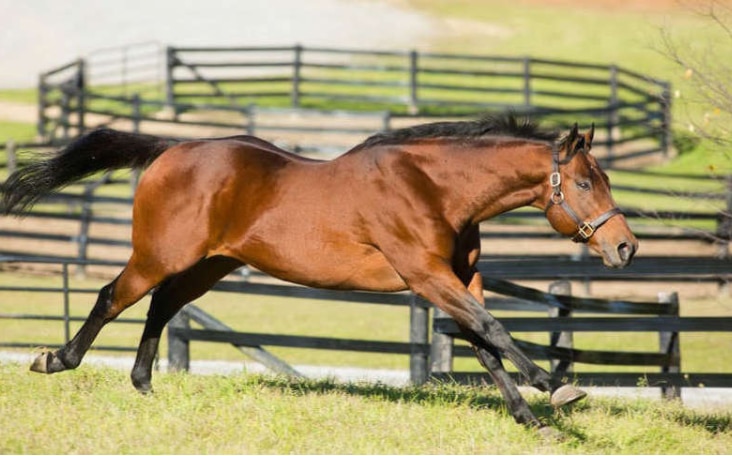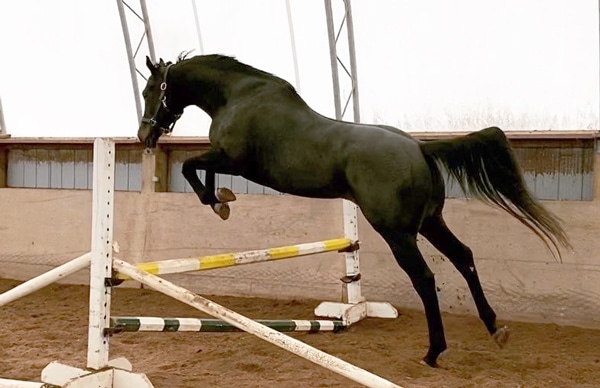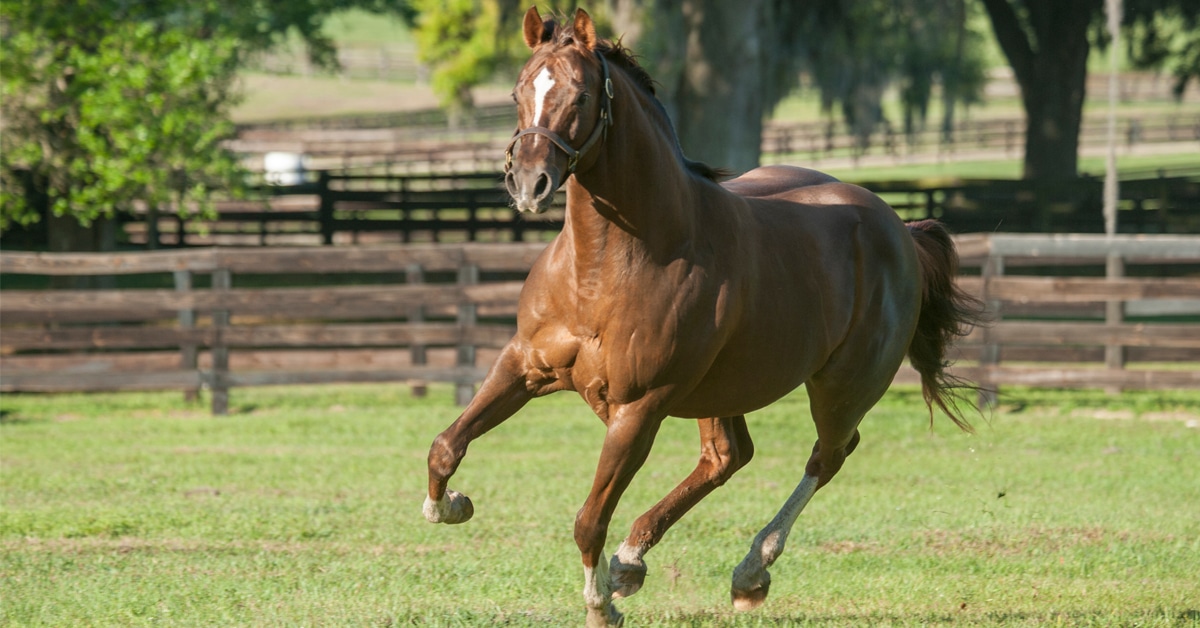The health and well-being of their stallions is always at the forefront of breeders’ minds, from fitness to nutrition, soundness to mental health, especially leading up to the start of the busy breeding season.
John Burness, who operates Colebrook Farms in Uxbridge, ON, outlined the daily exercise program for the six stallions currently standing at his farm: Where’s The Ring, Passion for Action, Ami’s Holiday, Frac Daddy, Avie’s Flatter and Perfect Timber.
“Right now, it’s just turnout,” Burness said. “We want to get the weight on them and get them ready for the breeding season. I start to build them up in the fall, with just regular turnout. During the breeding season, they obviously lose weight because they are busy working, so we try to get them in the best condition that we can.”

Ami’s Holiday romping at Colebrook Farms. Colebrook Farms photo)
In the business for over 40 years, Burness is keenly aware of the importance of keeping his stallion roster in prime condition before they resume an active schedule of breeding mares in the late winter, spring and early summer months.
Stallions are very much individuals, and what works for one might not suit another. “It’s like every human being, there is no one program that fits all. You’ve got to start adapting to what they need,” said Dermot Carty, who also has over four decades in the business. He has been the director of sales for Frank Stronach’s farm, Adena Springs, in Aurora, ON, since 2008,
Carty explains that daily exercise and diet are tailored to each of their stallion’s needs. Turnout time varies for each stallion, and one in particular enjoys additional turnout time. “Point of Entry doesn’t like to be inside. What we’ve done is adapted with blankets and a run-in shed outside that will protect him from the northern winds, so he can go outside and feel like he’s not claustrophobic, which is due to his size. He is quite a large horse. By allowing him to go outside, he feels a lot more relaxed, and when he comes in for breeding, he understands the process,” explained Carty.
Alongside Point of Entry, Adena Springs is also home to Silent Name, Signature Red, American Guru, and Shaman Ghost.
Ontario’s breeding season typically commences on February 14th and runs into the summer. Generally speaking, the ‘off season’ runs from mid-June to the beginning of February. At Adena, a stallion’s turnout time will increase during the off season.

Adena Spring’s Point of Entry. (Adena Springs photo)
“At the end of the breeding season, we gradually introduce them to being out for a period of time. So they will start outside for two hours, then three, four, and five hours. We also try to turn them out in the evening about four p.m. and then bring them back in at five a.m. It’s good for their minds because there is not a lot of traffic around, and they can see what’s around them.”
However, there’s a gradual shift in the turnout schedule as they begin to prepare for the upcoming breeding season.
“As we work towards the season, we bring the stallions inside and place them under lights. Part of the reason being is we want to acclimatize them to start thinking it’s spring, which helps with their libido and fertility,” said Carty. He also notes they are looking into light therapy designed by Equilume, which offers stable lights that more closely mimic natural daylight.
Adena’s state-of-the-art facility has been designed to maximize the health and well-being of each horse on the premises. “It’s very bright and airy. We have an air purification system that moves the air around every four minutes. We have lots of windows, which are designed so the animals can see out. We have very high ceilings, 20 feet in some places. The front of the stall doors are set up with bars on top and a cage at the bottom to allow air circulation. We do look at keeping the claustrophobic element out of it.”
Winters can be harsh and a horse’s paddock turnout is also at the mercy of mother nature. Stallions at Adena are also put on a walking machine, known as an equicizer, during both the off season and the breeding season.
“If we don’t have them breeding in the morning, then we can use the equicizer. If they have breeding in the morning, we try to give them a little bit of time around lunchtime where we can get them out for 15 to 20 minutes into the machine, and it makes them feel a lot better.”
Situated within the middle of Adena’s equicizer there’s a round pen where stallions can be exercised if need be.
Ridden exercise
At some stud farms, such as Shinzunai Stallion Station in Japan, residents including Creator and Makfi are given ridden exercise. Carty explains why riding is not incorporated into Adena’s stallion program.
“When Mrs. Abercrombie down at Pin Oak Stud was alive, the horses were ridden in the afternoons, but she only had two stallions. We have five, and we used to have about twelve at one time. Our investment in our horses alone is astronomical; between Point of Entry, Silent Name, Shaman Ghost, Signature Red, and American Guru, the figure is around US $27 million,” said Carty, underscoring the significant commercial value of each stallion. “We have found if we follow this [turnout and equisizer] routine, we just keep it safe.”

Sir Dudley Digges is starting his second career in the hunter/jumper world. (photo courtesy Candice Rainey)
While it may be too risky to ride stallions during their stud careers, it’s not unheard of. Just ask Candice Rainey, who owns Sir Dudley Digges. Rainey purchased the stallion earlier this year and is retraining him for a second career in the show ring while he continues his stud duties.
“I’ve basically restarted him all together into the hunter-jumper world,” said Rainey. “We are taking our time to make sure he is stress-free through it, because being a breeding stallion as well can be very stressful on them. He is still in the process of learning how to jump properly and safely through courses. By 2024 we are hoping to have him out and competing,”
The 2016 Queen’s Plate winner and 2018 Barbados Gold Cup champ is standing at Rainey’s farm, Signature Equestrian in Stayner, ON. The nine-year-old son of Gio Ponti has covered a couple of Rainey’s personal mares that are due in the spring.
While it may not be the norm to retrain an active stallion for a second career, Rainey has been impressed with Dudley in the time she’s spent working with him. “He is really smart. When we are in the ring and doing groundwork, letting him loose he will follow you and you wouldn’t even know he is a stallion.”
Alternative therapies
Michaela Kemp, the director of Ballycroy Bloodstock in Loretto, ON, notes that the breeding operation provides various forms of exercise options, including hydrotherapy.
“Although some stallions like it more than others, turnout is such an important part of a stallion’s routine and exercise. For alternative exercise we will use the aqua treadmill,” said Kemp.
Ballycroy is standing Grade 1 winners Collusion Illusion and Tamarkuz ‒ both new to the province ‒ at their newly-built facility for the 2023 breeding season. As noted by Steve Kemp, Michaela’s father, the stallions at Ballycroy also enjoy evening turnout. “The stallions have large individual paddocks which they get turned out year-round in. In the summertime, because of the hot weather, they tend to go out on night turnout when the flies aren’t as bad. We keep a flysheet on them and it’s a little cooler for them.”
Feeding for success
A stallion’s health is also very dependent on his diet.
Michaela explained, “Our stallions are on a base feed of a highly palatable performance horse feed that is high in fibre and protein. They also get a low-sugar, low-calorie pellet that is rich in proteins, minerals, and vitamins. This is to assure they are getting all the nutrients they need without putting on unwanted extra weight.

Collusion Illusion at Ballycroy. (Ballycroy Bloodstock photo)
“For Collusion Illusion coming off the track we also fed a high-caloric pellet to help put some weight on and build muscle. To get them ready for the open house [in October] and have them looking their absolute best for the breeding season, we enhanced their diets with fatty acid oil and an amino trace supplement, which I have seen great success with, so that horses are getting the most out of what they are eating.”
As was noted with exercise, the same adage, ‘one size does not fit all’ applies to a stallion’s dietary regime as well. Steve Kemp explains from his perspective:
“Each horse is an individual. You have to look at them and look at what their needs are to fulfill a good appearance. You want to see dapples on a horse, you want to see that it’s healthy, his eyes are bright, his ears are alert ‒ that sort of thing. A combination of a diet of proteins and nutrition and moisture in the diet is very important to avoid any colic. It’s more appealing to feed a horse smaller amounts frequently than a large amount twice a day, because the smaller amount is easier on their gut.”
He added that feeding four times a day is ideal. “We go on a four-time-a-day diet for our stallions and for our mares once they foal because it’s very important to keep their guts moving on a regular basis.”
Over at Colebrook, Burness said his stallion roster is also fed “morning, noon and in the afternoon. Three times a day.”
Carty described his stallion nutrition program. “We really watch what we feed, and we start introducing a very high-protein diet,” he said. “We try to keep away from certain types of feeds. We are not big believers in sweet feed per se because we make our own mix, because we want more natural stuff like honey and maple syrup added.”
Carty is also clear on why it’s important to limit the sugar within a stallion’s diet. “Raw sugar that’s added into sweet feed tastes good, but it’s just like drinking a bottle of Coke ‒ it will fatten them up and it’s not the good sugars that they are getting, and that can substantially reduce their libido.”
While each breeding operation differs in size and methods, there’s a sentiment that is carried through Carty’s words rings true for every breeder’s end goal.
“We always look to improve things. I mean, that’s Frank [Stronach’s] philosophy: make things better. And every chance you can get, keep making it better.”


